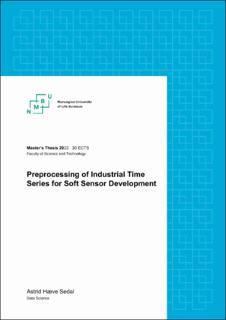| dc.description.abstract | With increasing population growth, the demand for food and proteins rises. The need for protein from poultry is projected to increase by 17.8% by 2030, and poultry production in Norway has never been higher. Nortura at Hæland/Norway processes chicken and is left with a significant amount of rest raw materials after production. To deal with waste management, Bioco, a bio-refining company located next to Nortura, has utilized the rest raw materials from Nortura. Through enzymatic hydrolysis, Bioco can transform the rest raw materials into high-quality end products while reducing waste and contributing to sustainable food production. However, the process line is prone to variation as the composition of the rest raw materials varies greatly. The sensors along the process line have gathered a vast amount of complex time series data that must be preprocessed to develop soft sensors.
This thesis presents multiple preprocessing steps, focusing on data filtering, feature engineering, and time series smoothing. Data filtering removed irrelevant spectra and process data, while feature engineering aimed to reduce the dimensions of the near-infrared data and created new features to enhance model performance. Smoothing eliminated noise in the time series data and revealed underlying patterns. Four smoothing methods were performed with a great range of window sizes. The methods were mean, median, linearly, and exponentially weighted smoothing. Finally, the preprocessed data were utilized as input data in two soft sensors, also termed machine learning models, to compare the impact of preprocessing on the soft sensors.
The application of mean and median smoothing methods resulted in smoothed time series, which had varying impacts on the performance of the machine learning models. While mean smoothing did not surpass the baseline model at lower window sizes, it demonstrated better results with larger window sizes. On the other hand, median smoothing led to more reliable predictions that performed well overall. In comparison, the linearly weighted mean generated the smoothest time series among the four methods and produced the most accurate predictions for larger window sizes. Exponential smoothing, however, yielded similar time series across different window sizes and did not significantly smooth the time series and may be related to the decay parameter used. Regarding the performance of the machine learning models, XGBRegressor predicted noisier time series than the RandomForestRegressor.
There are multiple remaining challenges regarding the preprocessing methods. The near-infrared data should be preprocessed in the spectral domain to correct multiplicative scattering effects, and different train/test splits should be performed, including cross-validation. Adding a smaller lagged feature of the target data to reveal temporal relationships is also recommended.
Due to the varied rest raw materials at Bioco, the process line sensors generate complex time series data with noise. Data filtering, feature engineering, and smoothing improved data quality. The results from the soft sensors highlighted the importance of choosing the right smoothing method and window size as a preprocessing step. Median smoothing with larger window sizes resulted in the most robust predictions. | |
